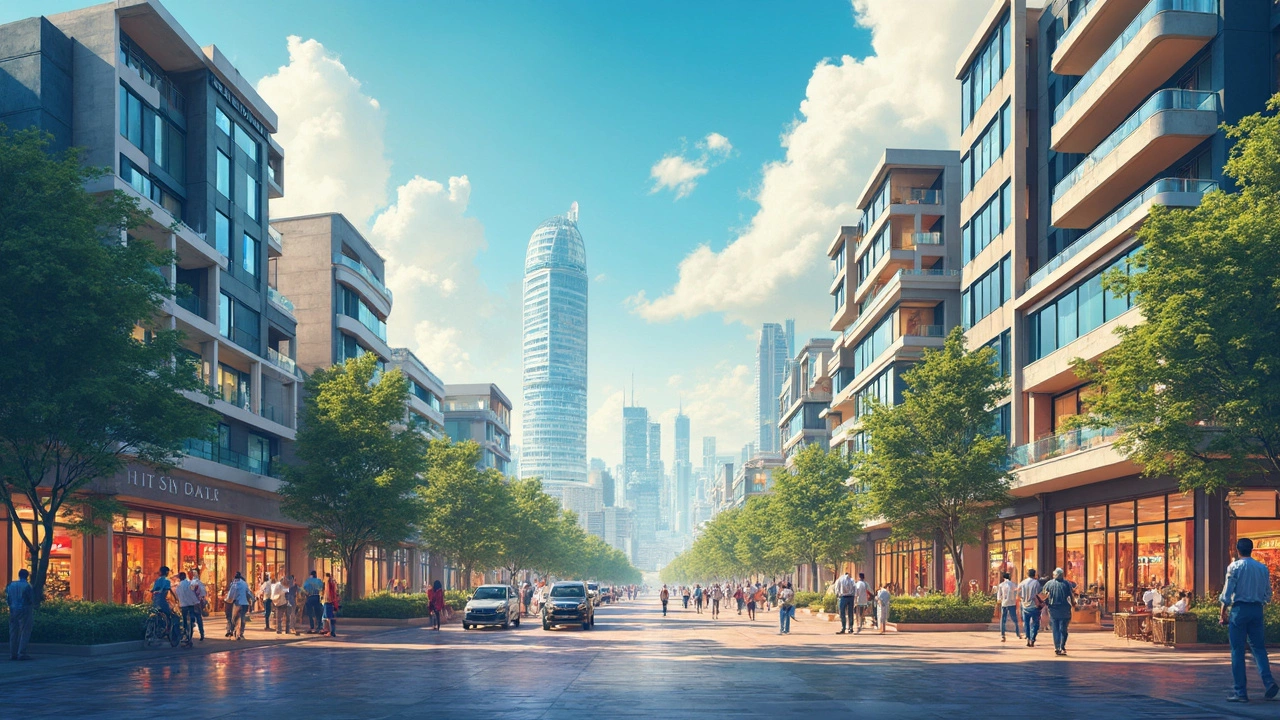Average Return on Commercial Property Explained

Ever wonder what you'd get back if you jumped into the world of commercial property? Turns out, understanding the average return can be a real game-changer for your investment plans. Commercial property is known for its potential to generate higher returns than residential real estate, but it's vital to know what influences those numbers.
Let's break it down. You're looking at factors like the property's location, the type of commercial property you're interested in (think retail, office, or industrial), and overall market trends when determining potential returns. For instance, investing in a bustling city center might offer higher returns, but it could also come with a heftier price tag. Meanwhile, a property on the outskirts might be less expensive and still provide solid returns.
Stepping into the commercial real estate market isn't just about knowing what the average return might be; it's about strategizing, understanding the nuances, and making informed decisions. So, let's dive a little deeper into how you can maximize those returns and what you might want to watch out for.
- Understanding Average Returns
- Factors Influencing Returns
- Types of Commercial Properties
- Tips for Boosting Returns
- Pitfalls to Avoid
Understanding Average Returns
When you're diving into commercial property investment, knowing the average return can really set your expectations straight. Typically, commercial real estate offers an average annual return between 6% to 12%, depending on various factors. You won't find this consistency in residential properties, which makes commercial property quite appealing to many investors.
The types of returns you get from commercial properties can be split into two main parts: rental income and capital gains. Your rental income is the ongoing money flow you get from tenants, while capital gains can come into play if you decide to sell the property later at a higher price.
Also, location matters—a lot. A property in a prime city location could give you a higher return, but remember, it might also come with higher upfront costs. On the other hand, properties in smaller towns or less-popular areas might cost less initially but could offer lower returns. Still, niche markets and up-and-coming areas can sometimes buck this trend, providing surprisingly good returns.
- Rental Yields: The rent you can charge will largely depend on the location and type of your commercial property. For instance, office spaces in bustling business centers can command premium rents.
- Capital Appreciation: Over time, property value can increase, especially if the area becomes more desirable or if you've made improvements to the property.
Investors often look at both the net rental yield and the potential for price appreciation when evaluating a property. A practical mix of these returns can lead to a healthy profit when weighed against operating and maintenance costs.
Here's a basic example to illustrate potential returns: If you buy a commercial space for $500,000 and the annual rental income is about $50,000, that's a 10% yield from rental income alone. If the property's value increases to $550,000 over five years, you've got an additional capital gain in your pocket.
Since markets change, staying updated with local market trends and economic factors is crucial in adjusting your strategies to hit or even exceed those average returns. This means keeping an eye on things like interest rates, local economic developments, and industry regulations that could impact rental rates or property values.
Factors Influencing Returns
Diving into commercial property investments can feel a bit like navigating trickier waters compared to residential. The returns? Well, they're shaped by a bunch of factors that are a bit unique to this field. Getting a handle on these can really tip the scales in your favor, making your investment that much more lucrative.
First off, let's talk about location. It's a massive player in determining average returns. Prime spots in bustling cities might command higher rents but come with their own sets of challenges and costs. Meanwhile, quieter areas might offer steadier investments with regular cash flow sans the high entry costs.
Then, there's the type of commercial property you're eyeing. Are you betting on an office space, retail unit, or maybe something industrial? Each comes with its specific risks and rewards. Retail spaces might rely on foot traffic, while office spaces need solid tenants with stability.
Market trends also matter. When the economy's booming, businesses expand, and demand for commercial property rises, often leading to better yields. Conversely, during a downturn, you might see more vacancies or pressure to lower rents.
Speaking of tenants, their credibility will impact your returns too. Secure yourself a reliable long-term tenant, and you're likely in for stable returns. But get stuck with someone shaky, and those returns might dip.
It's also worth noting the role of property management. Good management can mean the difference between seamless operations and constant headaches. Plus, those sneaky little things like maintenance costs can sneak up on you, affecting your bottom line.
Lastly, let's not forget about government policies and taxes. Regulatory changes, taxes, and any incentives can all influence how appealing and profitable a commercial property might be.
All these factors intertwine, creating a unique puzzle for every property. Get savvy with these influencers, and you'll be a step closer to maximizing your investment's potential.
| Factor | Impact on Returns |
|---|---|
| Location | Higher rent potential in prime areas, but also higher costs |
| Property Type | Diverse risk and reward based on type |
| Market Trends | Economic shifts can significantly impact vacancy rates |
| Tenant Stability | Long-term reliable tenants offer stable returns |
| Property Management | Efficient management leads to seamless operations |

Types of Commercial Properties
Stepping into commercial real estate, you've got a buffet of options. It's not just about picking the right property but knowing what kind fits your investment goals and risk appetite. Broadly, commercial properties fall into a few main categories.
Office spaces are a staple in the commercial domain. They range from sleek skyscrapers in business districts to smaller office parks. Prime city spots can come with steep price tags, but they also promise higher returns, especially if the property attracts top-tier tenants.
Then there's retail property. Think shopping centers, strip malls, and standalone stores. With everyone always needing places to shop, retail spaces can be lucrative. Be cautious, though—location is everything. A spot in a thriving mall could be golden, while a store in a declining area might spell trouble.
Next, we've got industrial properties, covering warehouses, factories, and distribution centers. With the boom of e-commerce, these types have been seeing some solid interest. While they might not have the glamour of an office tower, they often come with lower overheads and longer lease agreements.
Last but not least is multi-family dwellings. While typically more aligned with residential, when they're on a large enough scale (think apartment complexes), they slip into the commercial category. Consistent demand for housing makes this an attractive option.
- If stability's your thing, office spaces might be your jam.
- Ready for some action and risk? Retail properties could be your playground.
- Love long-term security? Industrial properties might just be what you need.
- Looking for consistent rental income? Multi-family dwellings are worth exploring.
Choosing the right type of commercial property depends on your strategy and market understanding. Each type carries its own set of potential returns and pitfalls, so choose wisely!
Tips for Boosting Returns
Want to squeeze the most out of your commercial property? It's a bit like crafting your favorite dish – a mix of the right ingredients makes all the difference. Here’s how you can cook up bigger returns:
- Do Your Homework: Dive into market research. Know the area like the back of your hand—what kind of businesses flourish there, upcoming infrastructure projects, and even the local competition. This knowledge can position you to make smarter investment decisions.
- Keep Properties Well-Maintained: First impressions matter. Maintaining the property not only helps in attracting reliable tenants but also keeps property values up. Regular checkups can save you from costly repairs down the line.
- Negotiate Lease Terms Wisely: Extended leases are your friend. They bring stability with long-term tenants. Plus, don’t forget to include rent escalation clauses to adjust rents over time with market conditions.
- Diversify Property Portfolio: Like they say, don’t put all your eggs in one basket. Invest in different types of commercial properties—maybe mix a bit of retail with some industrial spaces. This helps cushion against dips in certain sectors.
- Make Energy Efficiency Improvements: Go green! Sustainability is more than a trend; it's an expectation. Energy-efficient buildings attract environmentally conscious tenants and can save you money on utilities.
Here’s an interesting nugget: According to a 2023 industry report, commercial properties that implemented energy-efficient upgrades saw around a 15% reduction in operational costs annually. That’s not just good for the planet but your wallet too.
Remember, not all roads in the real estate investment world lead to gold, but these strategies should point you in the right direction. Stay nimble, stay informed, and let the returns follow.

Pitfalls to Avoid
Getting into the world of commercial property investments can seem like a surefire ticket to success. But it’s not all sunshine and rainbows. There are a few potholes on this road to riches that you should definitely dodge.
Firstly, don’t underestimate the importance of location. Investing in a poorly chosen spot can sabotage your returns from the get-go. Some places just don’t have the foot traffic or demand you need to keep the money rolling in.
Next up, let’s talk about due diligence. Skipping thorough research is a classic rookie mistake. Always check zoning laws, inspect the property for hidden issues, and understand the demographics before signing any papers.
Tenant troubles are another common pitfall. Bad tenants can lead to missed payments and maintenance headaches. A thorough vetting process helps, but sometimes even the best screenings don’t catch everything.
Misjudging property type versatility is something else that trips up new investors. Say you buy a retail space. If the retail sector slumps, having a space that can pivot to, say, mixed use or entertainment can be a real lifesaver.
Last but not least, cash flow management is crucial. Commercial properties often come with higher costs for maintenance and upgrades. Keep a financial cushion ready for those unexpected expenses.
Here's a quick reminder with some numbers:
| Common Pitfall | Impact |
|---|---|
| Poor Location Choice | Up to 30% less in returns |
| Skipped Due Diligence | Costly legal issues |
| Bad Tenants | Missed rental income |
| Inflexible Property Use | Lower occupancy rates |
| Poor Cash Flow Management | Financial strain |
Avoid these traps, and you’re more likely to see lucrative returns on your commercial property investments. A little caution upfront goes a long way!






Write a comment